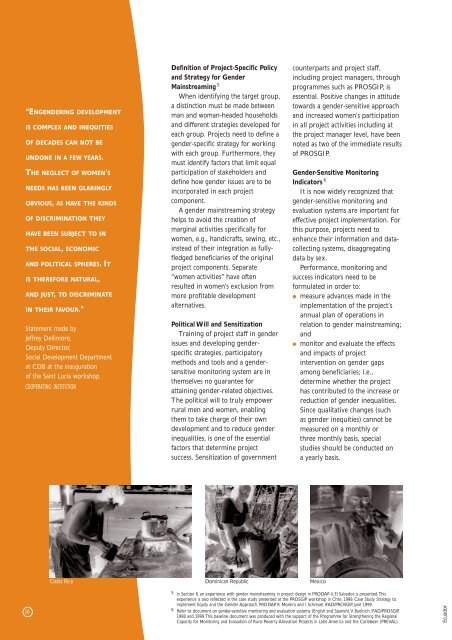III. Entry Points and Instruments for Gender Mainstreaming - IFAD
III. Entry Points and Instruments for Gender Mainstreaming - IFAD
III. Entry Points and Instruments for Gender Mainstreaming - IFAD
You also want an ePaper? Increase the reach of your titles
YUMPU automatically turns print PDFs into web optimized ePapers that Google loves.
“ENGENDERING DEVELOPMENT<br />
IS COMPLEX AND INEQUITIES<br />
OF DECADES CAN NOT BE<br />
UNDONE IN A FEW YEARS.<br />
THE NEGLECT OF WOMEN’S<br />
NEEDS HAS BEEN GLARINGLY<br />
OBVIOUS, AS HAVE THE KINDS<br />
OF DISCRIMINATION THEY<br />
HAVE BEEN SUBJECT TO IN<br />
THE SOCIAL, ECONOMIC<br />
AND POLITICAL SPHERES. IT<br />
IS THEREFORE NATURAL,<br />
AND JUST, TO DISCRIMINATE<br />
IN THEIR FAVOUR.”<br />
Statement made by<br />
Jeffrey Dellimore,<br />
Deputy Director,<br />
Social Development Department<br />
at CDB at the inauguration<br />
of the Saint Lucia workshop.<br />
COOPERATING INSTITUTION<br />
Definition of Project-Specific Policy<br />
<strong>and</strong> Strategy <strong>for</strong> <strong>Gender</strong><br />
<strong>Mainstreaming</strong> 5<br />
When identifying the target group,<br />
a distinction must be made between<br />
man <strong>and</strong> woman-headed households<br />
<strong>and</strong> different strategies developed <strong>for</strong><br />
each group. Projects need to define a<br />
gender-specific strategy <strong>for</strong> working<br />
with each group. Furthermore, they<br />
must identify factors that limit equal<br />
participation of stakeholders <strong>and</strong><br />
define how gender issues are to be<br />
incorporated in each project<br />
component.<br />
A gender mainstreaming strategy<br />
helps to avoid the creation of<br />
marginal activities specifically <strong>for</strong><br />
women, e.g., h<strong>and</strong>icrafts, sewing, etc.,<br />
instead of their integration as fullyfledged<br />
beneficiaries of the original<br />
project components. Separate<br />
“women activities” have often<br />
resulted in women’s exclusion from<br />
more profitable development<br />
alternatives.<br />
Political Will <strong>and</strong> Sensitization<br />
Training of project staff in gender<br />
issues <strong>and</strong> developing genderspecific<br />
strategies, participatory<br />
methods <strong>and</strong> tools <strong>and</strong> a gendersensitive<br />
monitoring system are in<br />
themselves no guarantee <strong>for</strong><br />
attaining gender-related objectives.<br />
The political will to truly empower<br />
rural men <strong>and</strong> women, enabling<br />
them to take charge of their own<br />
development <strong>and</strong> to reduce gender<br />
inequalities, is one of the essential<br />
factors that determine project<br />
success. Sensitization of government<br />
counterparts <strong>and</strong> project staff,<br />
including project managers, through<br />
programmes such as PROSGIP, is<br />
essential. Positive changes in attitude<br />
towards a gender-sensitive approach<br />
<strong>and</strong> increased women’s participation<br />
in all project activities including at<br />
the project manager level, have been<br />
noted as two of the immediate results<br />
of PROSGIP.<br />
<strong>Gender</strong>-Sensitive Monitoring<br />
Indicators 6<br />
It is now widely recognized that<br />
gender-sensitive monitoring <strong>and</strong><br />
evaluation systems are important <strong>for</strong><br />
effective project implementation. For<br />
this purpose, projects need to<br />
enhance their in<strong>for</strong>mation <strong>and</strong> datacollecting<br />
systems, disaggregating<br />
data by sex.<br />
Per<strong>for</strong>mance, monitoring <strong>and</strong><br />
success indicators need to be<br />
<strong>for</strong>mulated in order to:<br />
● measure advances made in the<br />
implementation of the project’s<br />
annual plan of operations in<br />
relation to gender mainstreaming;<br />
<strong>and</strong><br />
● monitor <strong>and</strong> evaluate the effects<br />
<strong>and</strong> impacts of project<br />
intervention on gender gaps<br />
among beneficiaries; i.e.,<br />
determine whether the project<br />
has contributed to the increase or<br />
reduction of gender inequalities.<br />
Since qualitative changes (such<br />
as gender inequities) cannot be<br />
measured on a monthly or<br />
three monthly basis, special<br />
studies should be conducted on<br />
a yearly basis.<br />
16<br />
Costa Rica Dominican Republic Mexico<br />
5 In Section 6, an experience with gender mainstreaming in project design in PRODAP-II, El Salvador, is presented.This<br />
experience is also reflected in the case study presented at the PROSGIP workshop in Chile, 1999. Case Study: Strategy to<br />
Implement Equity <strong>and</strong> the <strong>Gender</strong> Approach, PRODAP. R. Moreira <strong>and</strong> I. Schreuel, <strong>IFAD</strong>/PROSGIP, June 1999.<br />
6 Refer to document on gender-sensitive monitoring <strong>and</strong> evaluation systems (English <strong>and</strong> Spanish).V. Budinich. <strong>IFAD</strong>/PROSGIP,<br />
1998 <strong>and</strong> 1999.This baseline document was produced with the support of the Programme <strong>for</strong> Strengthening the Regional<br />
Capacity <strong>for</strong> Monitoring <strong>and</strong> Evaluation of Rural Poverty Alleviation Projects in Latin America <strong>and</strong> the Caribbean (PREVAL).<br />
Ecuador

















